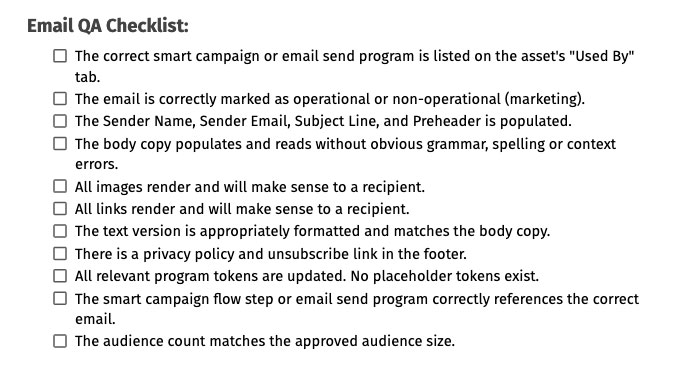Overview
Lost with the plethora of information out there telling you how to manage your email marketing campaigns? Unsure where to start or what to believe? What are email best practices? Why do they matter? How can your company ensure the marketers are using the best practices consistently? Read on for the answers.
What are Email Best Practices?
Email best practices are a set of standards to adhere to when creating emails to set email marketing efforts up for success. The checklist below can be used as a starting point:
- ✓ Segment audience that will receive your emails to ensure you are targeting the appropriate audience for relevancy
- ✓ Avoid no-reply emails to allow for the best possible perception from the recipient
- ✓ Write compelling (but concise) subject lines and keep subjects lines under 50 characters long
- ✓ Optimize the email’s preview text to increase engagement
- ✓ Have one main call-to-action (CTA) per email. Too many CTAs reduces engagement
- ✓ Keep the main message and CTA above the fold
- ✓ Use actionable language for your CTA (ie. Sign Up Now, Download Today, and Grab Your Seat)
- ✓ Personalize the emails whenever possible
- ✓ Make emails easy to scan by using short paragraphs, bullets, section headers, and graphics; avoid dense blocks of text
- ✓ Ensure design aligns to brand guidelines
- ✓ Email passes accessibility test (can use litmus or email on acid)
- ✓ Use responsive design (mobile friendly)
- ✓ If you are using images or emojis, make sure your email makes sense without them
- ✓ If you are using images or emojis, less is more. It is better to have one or two impactful graphics
- ✓ Always ask if the email provides value to the recipient; if the answer is no, consider if the email is worth sending
- ✓ Incorporate an easy way for recipients to unsubscribe
- ✓ Have a process in place to always have your emails QAed prior to approving/sending
- ✓ Set up templates to make email build consistent across all marketers
Why should companies implement Email Best Practices?
Email is one of the most effective ways to communicate with your audience to reach your target audience, build better relationships, and grow your business. Proper use of email best practices can result in better deliverability, open rates, click through rates, retention, website traffic, conversions & campaign ROI. Focusing on email best practices also allows companies to connect with customers and grow their business by turning subscribers into sales.
How should a company implement Email Best Practices?
Email best practices should be incorporated into all steps of your production process. These documented processes start with your intake process, specifically your content submission doc, which should outline best practices for requests. Email templates are also a great way to lock in best practices because they are the starting point for an email build and will set email builders up for the ideal scenario to adhere to the email best practices baked into email templates. As final assurance, a solid QA process for all emails is another opportunity to ensure email best practices are consistently being applied. Having a QA checklist as part of this process, which details what to look out for in adherence to best practices is the final step to ensuring all emails being sent follow the company’s best practices.

Building out best practices that work for your org should be tackled by the Marketing Operations (MOPs) team in conjunction with the teams developing marketing campaigns such as demand gen marketers and field marketers. It’s important for marketers to understand what the best practices are and how they influence campaign success. This understanding will make adherence to best practices easier and more consistent when viewed as a benefit instead of an order.
Conclusion
With consistent use of email best practices, companies can ensure their email efforts will result in the best possible performance. Consistent adherence to email best practices will increase the probability of creating a lasting impression on email audience members who will know who to turn to when they are ready to convert into a paying customer.







